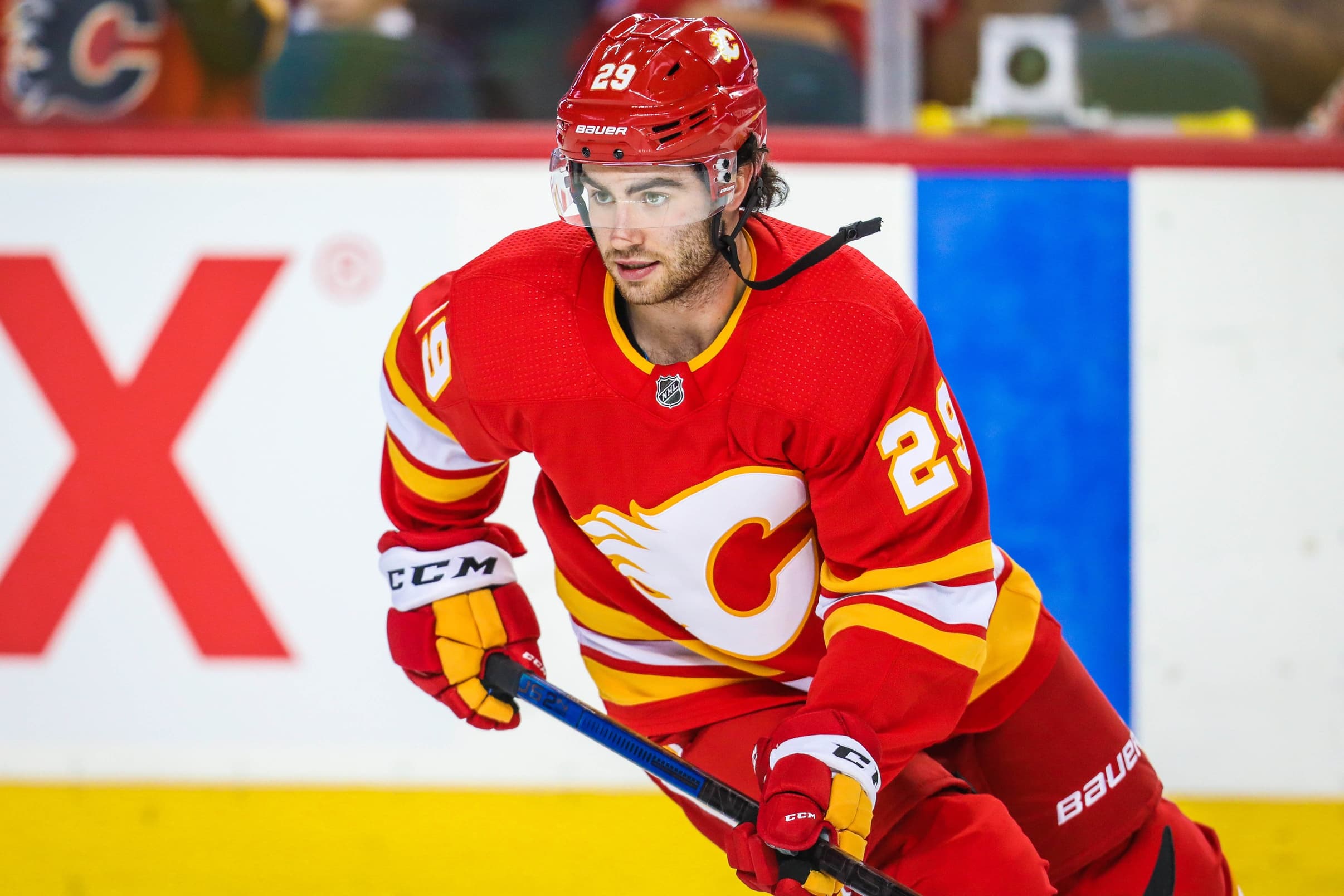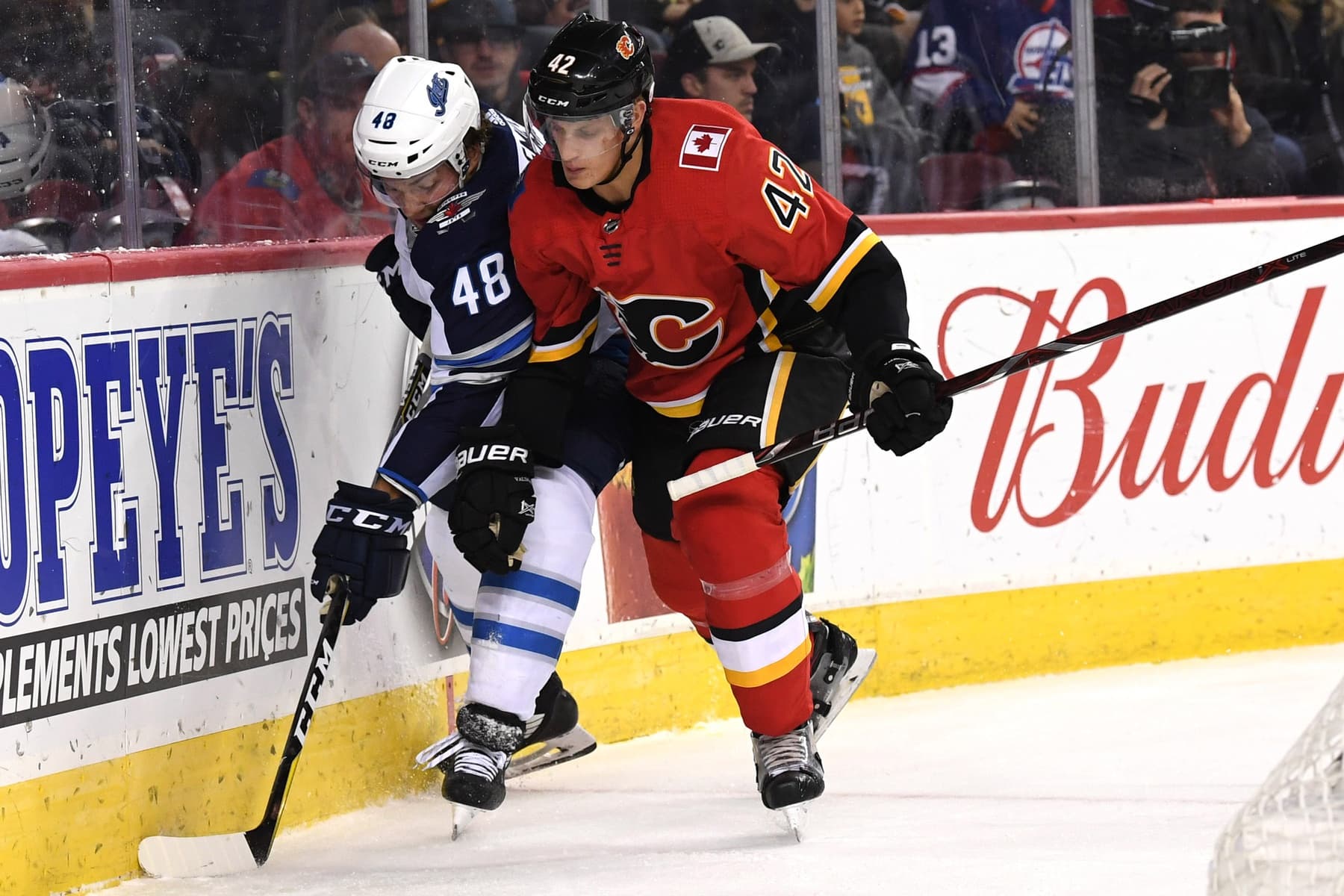Trio of Flames rookies finding their NHL footing

A quarter of the way through the season, the Flames are carrying three rookies as NHL regulars with no signs of that changing. Dillon Dube, Juuso Valimaki, and Rasmus Andersson are all forging identities as first year players with very similar results. We’ve certainly seen growing pains thus far, but all three players have high ceilings to be excited about. Most importantly, Calgary is investing in this trio and allowing the world’s best league to make them better players.
Unlike an earlier piece, it’s probably unfair to give letter grades to players still carving out their place in the NHL. Instead, we’ll employ a more black and white evaluation method for these three.
DILLON DUBE
With precisely zero professional experience, Dube burst onto the scene in training camp while the bulk of NHL regulars were in China. Impressively, Dube rode that momentum all the way to a spot in the opening night lineup. Now in a bottom six forward role, Dube has had plenty of expected hiccups while showing plenty of promise with his speed and hockey IQ. His on-ice totals at five-on-five are below with scoring chance data courtesy Natural Stat Trick.
| CF% | HDCF% | OZS% |
| 49.1 | 51.5 | 53.5 |
Dube is one of only three Flames forwards with a possession rate under 50%, but that’s not overly concerning. His most regular linemates, Mark Jankowski and Garnet Hathaway, are the other two players with red shot rates, and it’s only been recently that line has really started to find its groove. If that trio continues the way they’ve been playing of late, those numbers should improve.
Where the 2016 second round pick has struggled is with the finer points of the game. The coaching staff hasn’t been thrilled with his ability to chip pucks to help exit the zone, or to do the same thing to help get his line in on the cycle. Much of that has to do with physical maturity, though; a hard chip in junior is a little different than what it takes in the show, and Dube is learning that as he goes. As he gains strength this should cease to be a significant issue.
Where Dube shines, even as a rookie, is his ability to identify and place himself in good spots. He thinks the game at a high level, which helps him anticipate well and his high level skating allows his feet to keep up to his brain. The best evidence of this is the 13 individual high danger chances Dube has had on his stick this season; that puts him ninth on the team, which is notable knowing the limited role he’s played.
Grade: Pass. For the role he’s being asked to play, Dube belongs in the NHL without question. The only dilemma for the team is his usage, because you could argue his development is better served in the American League. If Dube is averaging 10-12 minutes a night on a regular basis, it’s my belief he belongs in the NHL. If that number starts to regularly drop to six or eight, though, send him to Stockton for a while where he can play a huge role.
JUUSO VALIMAKI

It’s not a regular occurrence to see a junior eligible defenceman play regular minutes on an NHL blueline, but that’s exactly what Valimaki has done all season. After a slow start to the preseason, Valimaki forced his way onto the opening roster and has appeared in all but three games to date (he’s currently week-to-week with a lower body injury). Valimaki’s minutes have been sheltered thus far, but I can’t remember many 20-year-old defencemen where that wasn’t the case.
| CF% | HDCF% | OZS% |
| 50.0 | 48.5 | 64.1 |
You can’t deny Valimaki has had his defensive miscues and his fair share of difficult games. His underlying metrics aren’t great, especially knowing how tailored his usage has been, but I’m not sure if we could expect much different. When you pair two rookies up on a regular basis, as Valimaki and Andersson have been most of the season, you generally have to accept some hiccups.
In saying that, there’s a lot to like here. Valimaki’s skill set has the potential to translate to a role much higher up the depth chart in the very near future. He’s an extremely gifted skater and has solid offensive instincts, which he’s had on display regularly during his rookie season. While Valimaki is still learning when and when not to jump into the play, I think you’d rather have to rein him in than the other way around.
I also really like how strong Valimaki is on his skates, which helps him in one-on-one puck battles down low. For a first year player with zero professional experience, Valimaki has routinely gone toe-to-toe with more physically mature players and come out on top. This should really serve him well as he progresses over the next few years.
Grade: Pass. To make the jump immediately from junior hockey to the NHL as a defenceman is difficult and rare. Valimaki’s promotion hasn’t come without growing pains, but I credit the Flames; they’ve accepted those mistakes and continue to invest in him with regular minutes. Valimaki possesses a lot of impressive tools and they’ve been on display plenty this season. I’m very intrigued to see where his game goes with more maturity.
RASMUS ANDERSSON

Sergei Belski-USA TODAY Sports
Much like Valimaki, Andersson’s first full year of NHL hockey has seen plenty of growing pains mixed with really promising stretches. The difference in Andersson’s case is he has a pair of American League seasons already under his belt, which makes his jump to the highest level a little less surprising.
| CF% | HDCF% | OZS% |
| 48.6 | 47.4 | 55.9 |
Andersson needs to improve on the defensive side of things, which includes his play away from the puck and the decisions he makes under duress with it. As it stands right now, Andersson is well slotted as a third pairing defender because you can play him against lesser opposition, which naturally lessens the opportunity for miscues.
In saying that, though, Andersson has made massive strides since joining the organization as a 2015 second round pick. Even from what we saw last year to now, Andersson’s skating has noticeably improved, as has his work defensively. It’s easy to accept hiccups from a rookie defenceman if you’re also seeing rapid progression, which I believe we are with Andersson.
I know his point totals don’t jump off the page right now (he has one assist in 22 games), but I really like the offensive potential for Andersson, too. That’s been on display a number of times late in games when we’ve seen Andersson on the ice with the goalie pulled trying to tie things up. He gets shots through well and walks the offensive blueline like a seasoned veteran.
Grade: Pass. Even with the relative defensive struggles we’ve seen, Andersson deserves to be a regular on this team. He passed Michael Stone on the depth chart on merit, and not because the veteran was playing poorly, either. With the way Calgary wants to play, Andersson’s ability to move the puck is a better fit. With Stone out long term recovering from a blood clot in his arm, there’s no real threat to Andersson’s time as a regular right now, either.
Recent articles from Pat Steinberg




